Aluminum alloy has low density, good corrosion resistance and excellent plasticity, and has unparalleled advantages of other lightweight materials in terms of production cost, parts quality, material utilization, manufacturing technology, mechanical properties, sustainable development, etc. Therefore, aluminum alloy has become the preferred lightweight material in the automotive industry.
Why choose aluminum for car?
Obvious weight loss effect
Aluminum has good mechanical properties, low density, good thermal conductivity, and the oxide film naturally formed on the surface has good corrosion resistance, making it the most ideal material for lightweight automobiles.
In addition, the lightening brought by aluminum alloys also allows the brake and other parts to reduce weight, that is to realize secondary weight reduction. According to data from Alcoa, the primary weight reduction effect of typical aluminum parts in automobiles can reach 30% to 40%, and the secondary weight reduction can be increased to 50%.
Strong shock absorption ability
The impact absorption capacity of aluminum is twice that of steel, which has obvious advantages in crash safety. In addition, the aluminum alloy car reduces the weight of the car without reducing the capacity of the car, the center of gravity of the car body is reduced, and the car is more stable and comfortable.
Easy to recycle
In the process of use, only slight corrosion occurs, and the melting point of aluminum alloy is low, which is convenient for remelting and recycling, and the recovery rate is higher than 80%. More than 60% of the aluminum alloy materials used in automobiles are recycled aluminum. Recycling and producing 1 ton of aluminum alloy consumes 95% less energy than reproducing 1 ton of aluminum alloy. The loss of aluminum is only about 5%. The energy saved by using aluminum is 6-12 times that of the original aluminum used to produce the part.
High assembly efficiency
The overall structure of the aluminum alloy automobile has fewer welding points, which reduces the processing process. The aluminum alloy overall body is about 35% lighter than the steel welded body, and does not require anti-rust treatment. Only 25% to 35% of the parts need spot welding, so, the assembly efficiency of automobiles can be greatly improved.
Aluminum in automotive industry
Aluminum alloys for vehicles mainly include rolled automotive body sheet, extruded aluminum profiles, forged aluminum parts, and cast aluminum alloys. At present, the proportion of various aluminum alloys used in automobiles is roughly: 77% of die cast aluminum, 10% of rolled car body sheet, 10% of extruded profiles, and 3% of forged materials.
The main components of aluminum alloys for automobiles are body, wheels, chassis, crash beams, floors, power batteries and seats.

Aluminum alloy profiles are widely used in automobiles. The auto body includes a body frame made of high-performance aluminum profiles, skins and doors made of high-precision aluminum automotive body sheets, aluminum alloy wheels and chassis, including high-strength and large-section aluminum structure parts and aluminum alloy forgings. Bumper, new energy bus floor, lithium ion battery, aluminum ion battery (including battery positive aluminum foil, battery aluminum shell and battery aluminum tray), new energy bus seat system etc.
Cast aluminum alloy is mainly used to manufacture new energy vehicle engine parts, shell parts and other parts on the chassis, such as car engine block, cylinder head, clutch shell, bumper, wheel, engine bracket and other dozens of parts.
Application of rolled aluminum sheet and coil in automobiles
Body sheet metal parts mainly include wings, load floors, bonnets, headliners, door skins and trunk lids.

| Alloys | 2008, 2010, 2036, 5052, 5083, 5022, 5023, 5182, 5754, 6009, 6016, 6022, 6111, 6016, 6181 |
| Thickness | 0.9-1.3mm |
| Temper | T4, O |
Advantages:
- Good bake hardening properties to obtain high strength to ensure concave resistance;
- Good formability to ensure stamping into various shapes;
- The surface is smooth and flat, without surface defects;
- Corrosion resistance to ensure sufficient life.
Aluminum for automotive heat exchangers
Automotive heat exchange systems include air conditioners, radiators, oil coolers, intercoolers and heaters, etc. With the acceleration of the lightweight process of automobiles, aluminum has gradually replaced copper and is widely used in the manufacture of automotive heat exchange system components.
Embossed aluminum heat shield plate
Most of the transmission systems of automobiles have heat shields, and more than 60% of the automobiles have at least one, and as many as five or six.
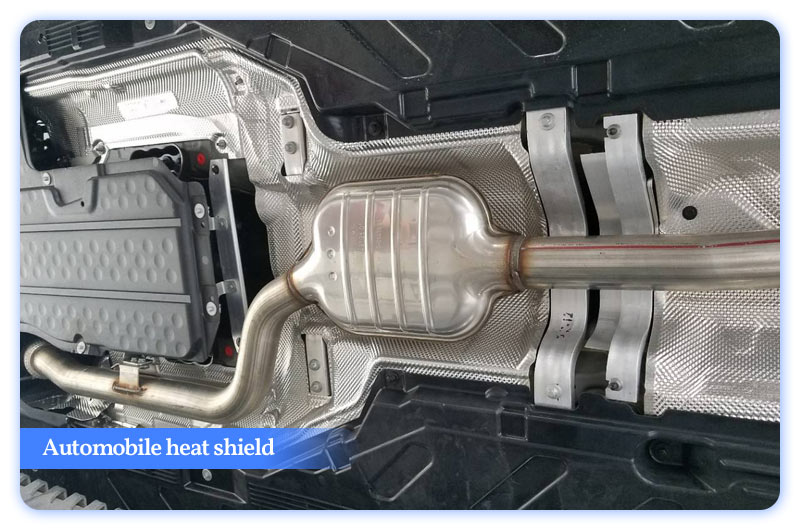
| Thickness | 0.5mm |
| Alloy | 1050, 3003, 5052, 5182 |
| Surface treatment | embossed |
Heat exchange aluminum
The most aluminum used in cars is the heat exchange system, which is the interior climate control system (HAVA=heater, ventilation and air conditioning). The aluminum content of the heat exchange system of each car is about 15 kg. In fact, radiators, condensers, evaporators and radiator cores are all made of aluminum.
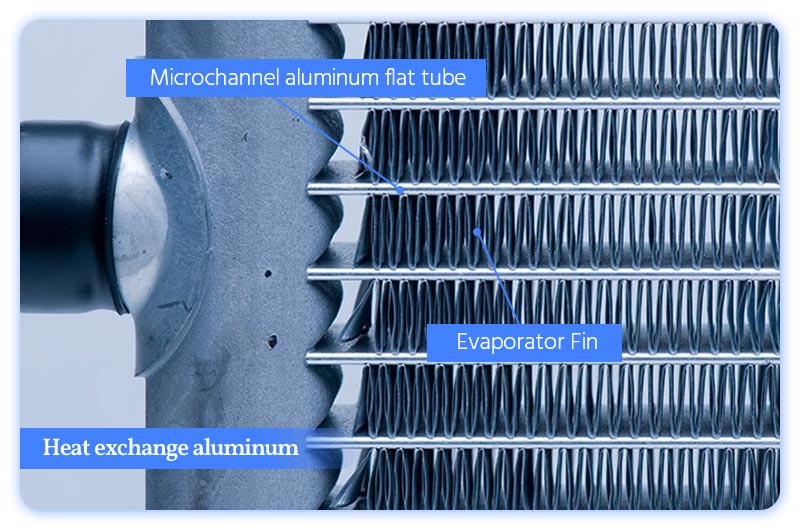
Aluminum water tank radiator
The aluminum water tank radiator is composed of a fluid conduit and cooling fins. The conduit is made of an aluminum alloy cladding coil strip through a high-frequency welding tube machine. The cooling medium passes through the conduit. The conduit and the fins are brazed into a whole to form the main body of the water tank radiator. The radiator is automatically brazed in a high-temperature special furnace at about 600 degrees Celsius. The welding of the pipe and the cooling fins should be firm. Therefore, the quality of the cladding aluminum alloy strip used in the manufacture of conduits has a direct impact on the quality of the water tank radiator.
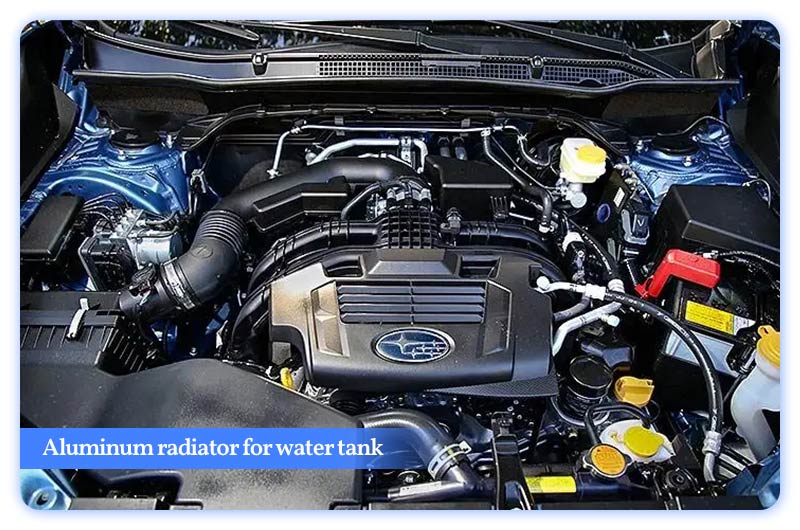
Radiator fin
| Alloy | 3003, 4343, 3003, 434, 6063, 3003+1.5% Zn |
| Radiator fin temper | H14 |
| Radiator fin thickness | 0.06-0.1 |
Radiator plate
| Alloy | 4343/3003/7072, 4343/3003 |
| Radiator plate temper | O |
|
Radiator plate thickness |
1.2-3mm |

Aluminum for Car Air Conditioner Heat Exchanger
Automobile air-conditioning radiators include evaporators and condensers. The raw materials of the evaporator are 1070, 3003 aluminum tubes and aluminum foils for cooling fins, and the raw materials for the condenser are porous aluminum flat tubes and aluminum foils for cooling fins. The aluminum tubes used in car air-conditioning radiators are more than 2 kg per car.
The evaporator aluminum tube can be made of 1050, 1060, 1070, 1070A, 1100 industrial pure aluminum, or 3003 alloy through extrusion, drawing and other processes. The material state is O state or H112 state, and the size is divided into ordinary grade and Sophisticated.

The flat tube of the condenser is a multi-empty tube, which is used as a fluid conduit in the heat exchanger, and a cooling medium flows through the inside of the tube during use. The wall of the hole is thin, there are many holes, and it is difficult to squeeze.
Condenser fin
Alloy: 4343, 3003, 4343, 4045+1.0%Zn/3003/4045+1.0%Zn
Thickness: 0.127mm, 0.115mm
Evaporator fin
| Alloy | 3003, 3003+1.5% Zn |
| Radiator fin temper | H14 |
| Radiator fin thickness | 0.06-0.1 |
Evaporator Plate
Alloy: 4045, 3003, 4045, 4045, 3003
Evaporator plate temper: O
Evaporator plate thickness: 0.40-1.0mm
| Alloy | 4045, 3003, 4045, 4045, 3003 |
| Radiator plate temper | O |
|
Radiator plate thickness |
0.40-1.0mm |
Aluminum cladding brazing sheet coil foil
Composite aluminum sheet, strip and foil are the core materials for the production of automotive heat exchangers, including radiator, intercooler, oil cooler, condenser and evaporator.
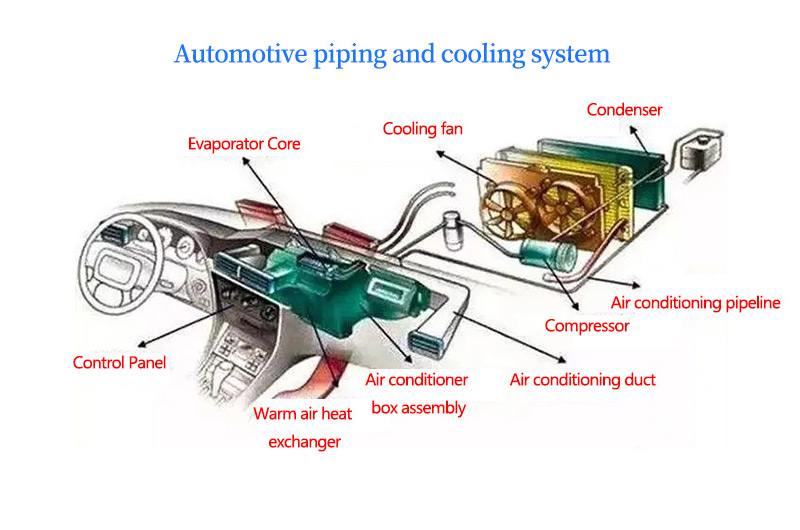
The aluminum brazing sheet coil foil is composed of one side or two sides of the base aluminum alloy covered with a low-melting point 4-series brazing alloy. The cladding layer is usually about 10% of the total thickness of the composite material. The melting point of the core matrix alloy is 630-660 degrees Celsius, and the melting point of the cladding layer is 577-610 degrees Celsius.
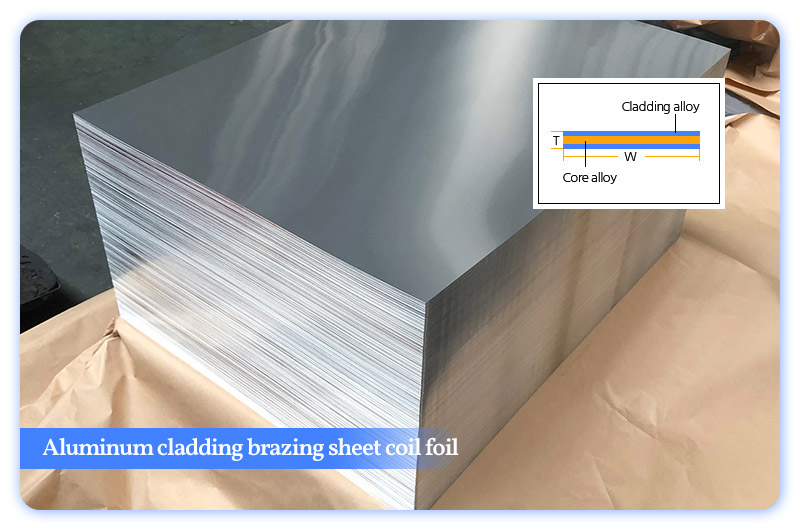
Cladding alloy: 4004, 4045, 4047, 4343, 7072, 4104, 4N43, 4N45, 4N04
Core alloy: 3003, 3003 + 1.5% Zn, 3003 + 1% Zn, 3004, 6063, 6951, 3N03, 3N23
Thickness: 0.04-6.0mm
Width: 10-1500mm
Characteristics:
- Anti-collapse performance;
- Extensibility guarantees bending forming;
- Corrosion resistance ensures the life of the radiator.
Aluminum for inlays, nameplates, license plates, decoration, car welcome panels
Alloy: 1100, 3002, 5005, 5252, 5457
Characteristics:
- The surface is smooth and flat, without surface defects;
- Corrosion resistance guarantees service life.

Aluminum for battery case, battery case cover
Alloy: 3003, 1050, 1060
Advantages:
Explosion-proof, high temperature resistance, corrosion resistance and other characteristics;
Good surface properties and stable chemical properties;
Good heat transfer, electrical conductivity and welding performance.

Application of extruded aluminum alloy profiles in automobiles
In addition to 6063 and 6061, the common aluminum alloy extrusions for body structure are different from American, Japanese and European ones.
American ones are mainly developed and applied by Alcoa and Alcan (BHTO), mainly including 6005A, 7003, etc.
Japan is dominated by alloys developed by UACJ Aluminum, Kobe Aluminum, Sumitomo, mainly including 6N01, 7N01, 7005, etc.
The European system is mainly based on the alloys developed by Hydro and Sapa Aluminum, mainly including 6082 and 6013.
In general, most of the six series alloys with medium strength or medium to high strength are used for body materials, and some of the 7 series alloys with low grade are used.
Aluminum alloy anti-collision beam
The anti-collision beam is an important part of the front and rear end protection devices of the car. When the vehicle collides at a low speed, the anti-collision beam part can transfer the collision energy to the energy-absorbing components such as the left and right energy-absorbing boxes in time, fully absorb the collision energy, and ease the external impact on the body. It plays an important role in protecting the structure of the car body, and at the same time protects the safety of pedestrians in collision accidents and reduces the accident rate.

The aluminum alloy anti-collision beam is mainly composed of an anti-collision beam, an energy-absorbing box, a mounting base plate and a tow hook sleeve. In order to strengthen the buffer and improve the impact strength, the cross-section of the aluminum alloy anti-collision beam is usually multi-cavity, using 6-series or 7-series extruded aluminum profiles; the section of the energy-absorbing box is mainly multi-cavity and hexagonal, using 6-series extruded aluminum profile; 6-series extruded aluminum profile is used for the installation base plate and tow hook sleeve.
Anti-collision beam, Alloy: 6082-T6, 6351-T6, 7003-T5, 7A46-T63;
Energy-absorbing box, Alloy: 6063-T6, 6060-T6;
Mounting plate, Alloy: 6005-T6, 6082-T6, 6063-T6;
Tow hook sleeve, Alloy: 6005, 6082, 6063;
Characteristics:
- Under the same collision and performance requirements, the aluminum alloy anti-collision beam is 35% to 60% lighter than the steel anti-collision beam;
- In the event of a collision, aluminum absorbs 50% to 70% more energy than steel, which improves vehicle safety while reducing the weight of the body;
- Aluminum has excellent corrosion resistance and can be recycled and reused, which is conducive to saving energy, protecting the environment, and promoting sustainable economic development.
Aluminum profiles for luggage racks and doorsteps
The luggage rack is located on the roof and is processed by three-dimensional precision bending. The material is 6063 T6. The requirements for the material are: good extrudability, cold formability and machinability to meet the requirements of three-dimensional precision bending and section distortion.
The doorstep is a part that requires decoration, and the 6063 T5 alloy extruded profile with good gloss and strong surface treatment ability can be used, which also has high requirements for the dimensional accuracy of the profile.

Precision aluminum tubes for automobiles
Aluminum tubes used in automobiles include extruded aluminum tubes, continuous extruded aluminum tubes, aluminum-copper clad tubes, cold drawn aluminum tubes, brazed aluminum tubes, etc.
The more used ones are:
Precision drawn aluminum tube for connection with the water tank.
Multi channel aluminum tubes for condensers, evaporators, air coolers, etc.
Brazed aluminum pipes for water tank connection, etc.
Extruded aluminum tube, used for water tank connection, etc.
Coated aluminum pipe, the surface is coated with paint to improve its corrosion resistance, used for the connection pipe at the bottom of the car.
Precision drawn aluminum tube
The alloys of precision drawn aluminum tubes mainly include 1060, 1070, 3003, 5049, 6061, 6063, 6082, etc. Their properties and sizes are as follows:
| Alloy | Temper | Tension strength / MPa | Out diameter / mm | Wall thickness / mm | Feature |
| 3003, 3103 | O, H112, H12, H18 | 95-180 | 6-24 | 0.3-2 | General purpose alloy, good formability, strong corrosion resistance. |
| 5049 | O | 180-250 | 9-18 | 0.8-2 | Medium to high strength, good formability and high corrosion resistance, especially in alkaline environments. |
| 6061, 6063, 6082 | O, T4, T6, T83 | 90-180 | 6-18 | 0.5-2 | Low to high strength, good formability, high corrosion resistance, especially in acidic environment. |
Multi channel aluminum tubes
The multi-channel aluminum tube is also called harmonica shape aluminum tube. It is named because its section resembles a harmonica. During use, the medium that needs to be cooled flows through the tube. The number of holes in the harmonica aluminum tube is generally 5-25, up to more than 60, the wall thickness is 0.1-1.0mm, and the height is about 5mm. It is used to manufacture the belt condenser. The user first puts the harmonica tube on the special tire. The top of the tool is coiled into a snake shape, and then the wave-shaped heat dissipation belt processed by composite aluminum foil with a thickness of 0.15-0.20mm covered with brazing material is assembled with the harmonica tube, and then welded into a heat sink in an inert gas brazing furnace. Exchange the condenser of the system.
Alloy: 1035, 1050, 1070, 3003, 3102, 6063
Harmonica pipe specifications, dimensions and deviations:
| Specs/mm L × H | Dimension deviation/mm | Wall thickness and tolerance/mm | Number of holes/piece | |
| L | H | |||
| 12×6 | +/-0.15 | +/-0.1 | (0.6-0.8)+/-0.05 | 18 |
| 100×6 | 16 | |||
| 64×6 | 12 | |||
| 48×6 | 10 | |||
| 44×6 | 8 | |||
| 32×5 | 8 | |||
| 26×5 | 6 | |||
| 22×5 | 6 | |||
Features:
- Harmonica has thin wall, many holes, and small inner cavity area;
- Good plasticity, strong fluidity, moderate strength, good weldability, high corrosion resistance;
- Alloy structure without defects, no cracking during cold deformation.
Aluminum pipes for intake manifold and fuel
The intake manifold, the duct that carries air drawn in by the throttle valve into the engine, is a critical component. As the performance of the engine improves, the shape of the manifold becomes more complex and its quality improves, so there is an urgent need for weight reduction. Usually, 6063 H112 alloy drawn aluminum tube is used, the wall thickness is 2mm, and it is bent by a spinning stretching machine.
Aluminum tubes for fuel used to be made of steel or aluminum castings, but now they have been replaced by extruded 6063 T5 or 6061 T6 aluminum tubes, which reduce the quality, simplify the manufacturing process, reduce the cost and improve the quality.
Other Automotive Aluminum Profiles
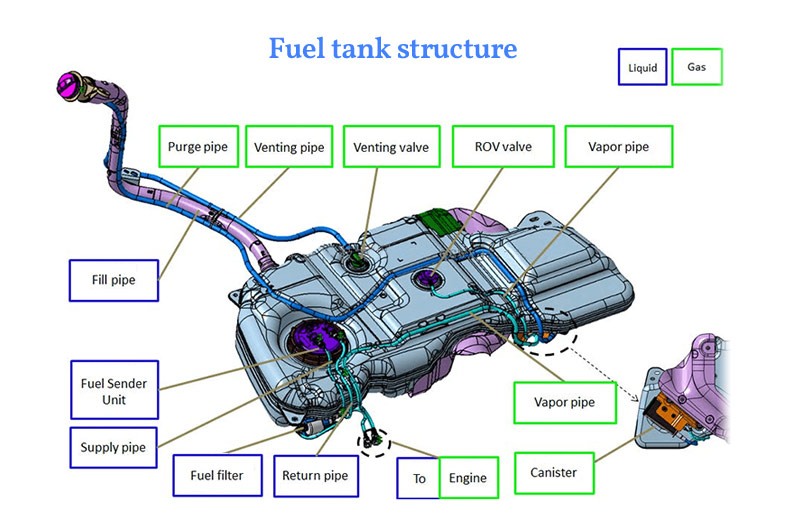
Suspension, bracket, bumper, drive shaft yoke, various support
| Alloys | 5454, 6005, 6010, 6061, 6063, 7021, 7029, 7129 |
| Car door, alloy | 6005 |
| Radiator: fin alloy | 1050 |
| Base plate alloy | 6063 |
Transmission system parts, connectors, door frames, window frames, trunk and hinge
Alloys: 6063, 6463, 6151, 6262
Seat rail, shock absorber bar, alloy: 6010, 7003, 7029, 7129
Brake system components, fasteners, screw, alloys: 2011, 2017, 2024, 6061, 6053

Advantages of extruded aluminum alloy profiles in automobiles:
- High tensile and impact strength and excellent plasticity;
- Good extrudability, elongation ≥ 10%;
- Weldability;
- Corrosion resistance;
- Stress corrosion cracking resistance;
- High fatigue strength.
Application of aluminum forging parts in automobile
The aluminum forged parts are mainly those with high mechanical performance requirements, such as wheels, chassis suspension system control arms, steering knuckles, air conditioning compressor scroll plates, etc.
The material grades used for typical aluminum forged parts of automobiles are mainly 6 series, such as 6060, 6061, 6066, 6082, etc. Some products also need to use 2 series, 4 series, 5 series and 7 series materials, such as 2014, 4032, 5754, 7075, etc.
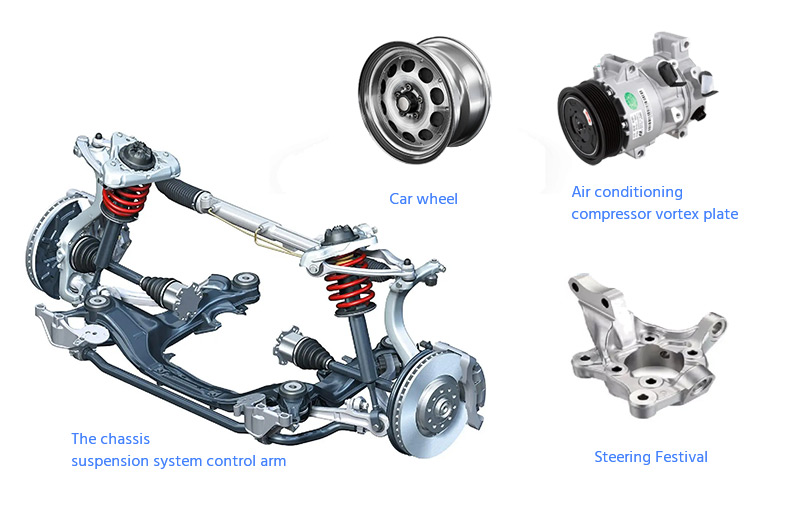
Wheel, bumper, base beam, front beam, crankshaft
Alloy: 1100, 5083, 5056, 6061, 6082, 6070
Advantages:
- Good plasticity and impact resistance;
- High fatigue life;
- Strong bearing capacity;
- Good corrosion resistance.
Application of aluminum castings in automobile
The parts produced by casting process are mainly shells and supports, such as engine cylinder head, gearbox housing, steering gear housing, engine bracket, steering gear bracket, etc.
Engine cylinder head, engine cylinder block, intake pipe, engine piston alloy: A319, A356, A360, A390, A339, ZL104, ZL106, ZL107

Bracket cover, steering gear, alloy: A380
Wheel, alloy: 5454, 6010, A356, 6061
Transmission system, chassis traveling system, alloy: A356, A360, A383, A390, ZL104, ZL107, Z202
Performance:
- Good casting performance;
- High strength, wear resistance, corrosion resistance and heat resistance;
- Lightweight and thin-walled. Contact us for aluminum alloys for automotive Industry.
Contact us for aluminum alloys for automotive industry
In the modern automobile manufacturing industry, the use of aluminum alloy is gradually increasing, and has been widely used in many important automotive component systems. With the continuous development of aluminum alloy manufacturing technology, it is believed that more new aluminum alloy materials will be successfully developed and applied to the automobile manufacturing industry in the future, thus promoting the sound and rapid development of modern automobile manufacturing industry.
Aiboer Technology provides automotive aluminum body sheets, aluminum profiles and forged aluminum parts to automotive industry for different applications, with our team of highly trained and experienced engineers and technicians, we can help you meet all of your land transportation industry goals. Extruded aluminum and rolled aluminum can be created according to your specifications, including standard size or custom aluminum solutions, as needed.
